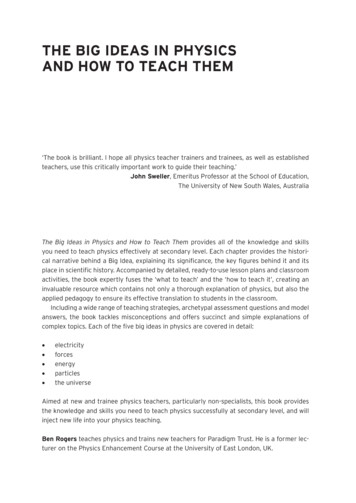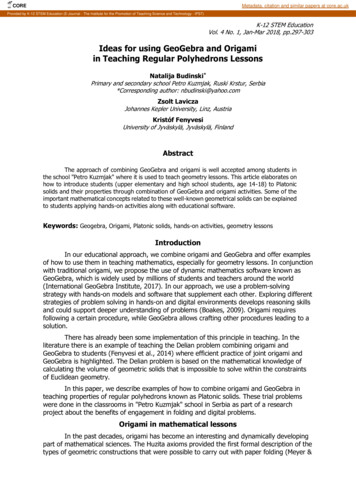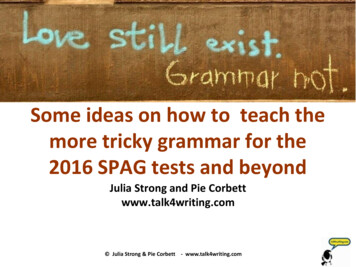
Transcription
THE BIG IDEAS IN PHYSICSAND HOW TO TEACH THEM‘The book is brilliant. I hope all physics teacher trainers and trainees, as well as establishedteachers, use this critically important work to guide their teaching.’John Sweller, Emeritus Professor at the School of Education,The University of New South Wales, AustraliaThe Big Ideas in Physics and How to Teach Them provides all of the knowledge and skillsyou need to teach physics effectively at secondary level. Each chapter provides the historical narrative behind a Big Idea, explaining its significance, the key figures behind it and itsplace in scientific history. Accompanied by detailed, ready-to-use lesson plans and classroomactivities, the book expertly fuses the ‘what to teach’ and the ‘how to teach it’, creating aninvaluable resource which contains not only a thorough explanation of physics, but also theapplied pedagogy to ensure its effective translation to students in the classroom.Including a wide range of teaching strategies, archetypal assessment questions and modelanswers, the book tackles misconceptions and offers succinct and simple explanations ofcomplex topics. Each of the five big ideas in physics are covered in detail: electricityforcesenergyparticlesthe universeAimed at new and trainee physics teachers, particularly non-specialists, this book providesthe knowledge and skills you need to teach physics successfully at secondary level, and willinject new life into your physics teaching.Ben Rogers teaches physics and trains new teachers for Paradigm Trust. He is a former lecturer on the Physics Enhancement Course at the University of East London, UK.
THE BIG IDEAS INPHYSICS AND HOWTO TEACH THEMTeaching Physics 11–18Ben Rogers
First published 2018by Routledge2 Park Square, Milton Park, Abingdon, Oxon OX14 4RNand by Routledge711 Third Avenue, New York, NY 10017Routledge is an imprint of the Taylor & Francis Group, an informa business 2018 Ben RogersThe right of Ben Rogers to be identified as author of this work has beenasserted by him in accordance with sections 77 and 78 of the Copyright,Designs and Patents Act 1988.All rights reserved. No part of this book may be reprinted or reproducedor utilised in any form or by any electronic, mechanical, or other means,now known or hereafter invented, including photocopying and recording,or in any information storage or retrieval system, without permission inwriting from the publishers.Trademark notice: Product or corporate names may be trademarksor registered trademarks, and are used only for identification andexplanation without intent to infringe.British Library Cataloguing-in-Publication DataA catalogue record for this book is available from the British LibraryLibrary of Congress Cataloging-in-Publication DataNames: Rogers, Ben (Physics writer), author.Title: Big ideas in physics and how to teach them: teaching physics 11-18 /Ben Rogers.Description: Abingdon, Oxon: Routledge, 2018.Identifiers: LCCN 2017059174 (print) LCCN 2018002921 (ebook) ISBN 9781315305431 (ebook) ISBN 9781138235076 (hardback) ISBN 9781138235069 (pbk.)Subjects: LCSH: Physics teachers—Training of. Physics—Study andteaching (Secondary) Physics—Study and teaching—Activity programs.Classification: LCC QC30 (ebook) LCC QC30 .R635 2018 (print) DDC 530.071—dc23LC record available at https://lccn.loc.gov/2017059174ISBN: 978-1-138-23507-6 (hbk)ISBN: 978-1-138-23506-9 (pbk)ISBN: 978-1-315-30543-1 (ebk)Typeset in Interstateby Deanta Global Publishing Services, Chennai, India
For Denise, Laura and Hannah
o31A big idea about learningWorking memory 3Long-term memory 4External environment 4How can we use Cognitive Load Theory to accelerate learning?Knowledge 10Archetypal questions 10Model-based problem solving 11The privileged status of stories – Willingham 11Misconceptions – When knowledge is wrong 11Practical work in physics 13Reducing Cognitive Load for practical work 13Literacy – A different sort of physics problem 14What are the Cognitive Loads associated with reading andhow can we reduce them? 14What are the Cognitive Loads of writing and how can wereduce them? 16How to teach writing in physics 18Conclusion 18Electricity Introduction 20A history of electricity 20Electricity in the ClassroomMisconceptions 38Archetypal questions 40Models 40Model based reasoning 4152036
viii ContentsPractical electricity 43Example lesson plan 44Conclusion 472 Forces at a distance Petrus Peregrinus, Crusader – 1269 50William Gilbert of Colchester, Physician to Queen Elizabeth I – 1600 50Newton’s Law of Universal Gravitation – 1687 51Faraday’s lines of force – 1852 53Maxwell’s equations: The second great unification in physics – 1865 54Einstein’s curved space – 1915 55Fermi’s nuclear forces – 1933 55Teaching forces at a distance 56Archetypal questions 58Using strategies from cognitive psychology in lessons 59Using demonstrations and practical work for writing 61Example lesson plan 63Conclusion 67493 Energy A short history of five energies 69Kinetic energy and potential energy: Descartes and Leibniz – 1644and 1676 70Chemical energy and heat energy: James Joule – 1843 71Nuclear energy: E mc2 – 1905 72Teaching energy 73Types of energy – stores and pathways 73Misconceptions 73Archetypal questions 74Using strategies from cognitive psychology in lessons 76Reading and writing 76Reducing Cognitive Load 77Example lesson plan 77Conclusion 85694 Particles Introduction 87A history of particles 87But atoms are not real. Or are they? Einstein – 1904 89Rays, beams and other phenomena – 1869 to 1899 91Pieces of atoms – 1897 to 1899 92Disproof of the pudding: Rutherford’s astonishing career – 1900to 1921 93Neutrons and war – 1932 to 1945 95Teaching particles 9687
Contents ixMisconceptions 96Archetypal questions 97Useful strategies from cognitive psychology in lessonsExample lesson plan 101Conclusion 105Notes 1055 The universe Introduction 107The telescope – 1608 110Teaching the universe 115Misconceptions 115Archetypal questions 117Models 118Practical astronomy 123Example lesson plan 126Conclusion 129BibliographyIndex99107130133
PREFACEThis book is written for every new physics teacher, whether you are new to teaching or newto teaching physics. Recruiting new physics teachers is difficult. In 2015/16 in England: 29% of the 1,055 physics training places were unfilled.28% of physics lessons were taught by teachers without post A-level experience.(DfE 2016)The initial idea for the structure of this book came from a report published in 2010 by theAssociation of Science Education (ASE): ‘The Principles and Big Ideas of Science Education’,edited by Wynne Harlen. The report identified fourteen ‘Big Ideas’ of science education.I have fewer big ideas for physics teachers. The ideas I have chosen are electricity, forces ata distance, energy, particles and the universe. Each of these big ideas has its own stories andits own pedagogy. This book has a chapter for each.But the book starts with a different sort of big idea: a learning theory. I have usedJohn Sweller’s Cognitive Load Theory to explain why I have chosen specific activitiesand approaches.Whether you are an experienced teacher, teaching physics for the first time or new to theprofession, thank you. My aim is to help you enjoy teaching physics and to teach it well.
ACKNOWLEDGEMENTSThis book began as a physics knowledge enhancement course at Thetford Academy. I got towork with enthusiastic, skilled teachers who were teaching physics but who weren’t experienced physics teachers. I want to thank Adrian Ball for initiating the course and for encouraging me to write the book, and all of the participants of the course for their encouragementand feedback.The narrative element of the book was developed from a discussion with DaisyChristodoulou about the importance of narrative in learning. We wanted a text which told thenarratives of science, something like Bill Bryson’s A Short History of Nearly Everything butaligned with the curriculum. Half of this book is dedicated to those narratives.I would like to thank Alan Weller of UEL for guiding me through the early stages of findinga publisher and Bill Holledge of Paradigm Trust, Dr Jo Saxton of Turner Schools and TonySherborne of the Centre for Science Education, Sheffield Hallam University for helping meclear the first hurdles.I am grateful for generous feedback on the first chapter from Professor Dylan Wiliam andProfessor John Sweller. The errors which remain are my own.My thanks also to Dr Lucy Rogers, Richard Heald and Simon Laycock for their feedback onthe writing and their encouragement.Finally, I owe so much in my life and career to Denise Dickinson, who has been by my sidesince I first learnt to teach, guiding and encouraging me and along the way teaching me towrite a little better.
INTRODUCTIONKnow how to solve every problem that has been solved.Richard FeynmanYou are a new physics teacher – you have been asked to teach students how to be physicists.This means teaching students how to become physics problem solvers.A physicist is the sum of the problems she can solve. She knows the conservation ofenergy when she can solve all of the problems associated with it. Knowing all the problemslets you solve new ones:the science student, confronted with a problem, seeks to see it as like one or more of theexemplary problems he has encountered before.(Kuhn 1977: 297)In other words, to become a better problem solver, a novice physicist needs to be exposedto as many archetypal questions as possible. More than that, she needs to be exposed toarchetypal questions in as many guises as possible, until she can see the underlying deepstructure of a question.This is a book about solving physics problems. It is about the knowledge a learner needs tobecome an expert. It is about the archetypal problems every physics student needs to learn.It is about how to teach them as efficiently and effectively as possible.In 1966 Richard Feynman gave an interview about teaching physics. He said that there isusually a problem in physics lessons – the students do not know where they are. His solution:“there always should be some kind of a map” (Feynman 2010: 16).I have constructed this book around a map. I started by writing the stories around a timeline for five big ideas of physics: electricity, forces at a distance, energy, particles and theuniverse. Figure i.1 is a map I made of the big ideas of physics.This book is about teaching these five big ideas. Each chapter starts with the story of thebig idea. Stories find a way of lodging in our brains. I use the stories as a base to build knowledge onto. But before I start with the big ideas of physics, I need to explain about another bigidea in this book: a big idea about learning.
2 Introduction150016001700BrowneVON KLEIST/ VANMUSSCHENBROEK(LEYDEN TRICITYHERSCHELJJ THOMPSONCURIEMAGNETISMGRAVITY1900GALVANI/FRANKLIN VOLTA FARADAYGRAYMAXWELLGUERICKEGILBERT URIEBOHRRUTHERFORDNEWTONTHE ENERGYDESCARTESLEIBNIZSHAKESPEARE KING JAMES BIBLE PEPYSREPRESENT THEPUBLICATION OF ANIMPORTANT TEXTJOULEDICKENS CONRADDEFOE GOETHE AUSTEN BRONTËDU CHÂTELETORWELLFigure i.1 A series of timelines showing when key events in the history of physics took place
Zero A big idea about learningThis idea is Cognitive Load Theory (CLT), which has been slowly gaining recognition sinceit was first developed by John Sweller in the 1980s. I have used the theory throughout thisbook to recommend activities and strategies and to explain why they work. CLT is not atheory-of-everything, but it helps explain how we learn to solve problems.CLT emphasises two types of memory: working memory and long-term memory, how theyinteract with each other and the external environment, as shown in Figure 0.1.whiteboardtextbooknotesteacherWorking memorypartner¼ and manymore.The external environmentLong-term memoryFigure 0.1 A model illustrating the external environment, working memory and long-termmemoryWorking memoryWhen we solve a problem, we store relevant, temporary information in our working memories.It is our mental workbench. Typical information manipulated in our working memories includes:
4 A big idea about learning data to solve the task;information about the task;relevant processes and strategies;information about social interactions (I use group-learning a lot in my classes).The first important thing for teachers to know is that working memory is easily overloadedwhen dealing with novel information. Keeping track of three ideas is usually too much. If youare asking students to carry out a novel task, collaborating with new people using knowledgethey haven’t memorised, and hope that they will be able to reflect on their learning at thesame time, you may be out of working memory and out of luck.The second thing to know is that solving a problem at the limit of her ability does not allowa student to reflect on the process - a vital part of learning. So, even if the learner gets theproblem right, you may have wasted learning time.Long-term memoryThe reason that some of us are better at solving problems than others is mainly due tolong-term memory. If you have two capable students solving a problem, the one with themost relevant knowledge in her long-term memory is more likely to be successful. Relevantknowledge includes: subject knowledge – facts and the relationships between facts.learning knowledge – how to access the knowledge we need to solve a problem.general knowledge – the information we assume others know. This is important for effective communication, especially when examples or questions are set within a context; forexample, an examiner, textbook writer or teacher may assume the student knows aboutAfrica, audio cassettes, the Tudors or snow.social knowledge – understanding the relationships, roles, rules and expectations ofthose around us. Social knowledge is key to solving problems in the real world.We store our long-term memories as schemata – networks of knowledge organised in meaningful ways. To become better problem solvers, students need richer schemata with moreknowledge, connected more meaningfully. For example, a student with a well-developedschema about pressure will know the effects of pressure on: living things; elephant feet,high-heeled shoes, snow-shoes and drawing pins; submarines and high-altitude balloons; thebends; early vacuum pumps and the Magdeburg hemispheres; the gas laws (Boyle’s, GayLussac’s and Charles’) and their history; Boltzmann and the kinetic theory of gases; Brownianmotion; and a bunch of equations involving pressure.External environmentOur working memories can only take in a small amount of information from the externalenvironment at one time, which then rapidly fades. This is important for teachers because weinfluence our students’ external environment: the whiteboard, a demonstration, a worksheet,
A big idea about learning5the classroom display, the seating plan. The aim is to focus attention on relevant informationand reduce distractions.Learners also influence their external environments. When a task gets tricky and workingmemory gets strained, effective learners use their external environment to reduce the loadon their working memories. That’s why we count on fingers, do calculations on the backs ofenvelopes and work with others (making use of their working memories too). Every photo of aphysicist shows a blackboard full of indecipherable, chalky marks – the classic useful externalenvironment. Marking-up texts and diagrams, making notes, answering questions neatly andworking effectively with peers are important strategies for learning.How can we use Cognitive Load Theory to accelerate learning?The first lesson from CLT is that students who know more, who have better developed schemata, are better at solving problems. If your primary goal as a physics teacher is to teachyour students to be better problems solvers, your primary strategy has to be teaching yourstudents more knowledge.The second lesson is that reducing Cognitive Load makes learning more effective. Whenyou reduce the Cognitive Load, learners solve problems more effectively and learn more.Reducing Cognitive Load means stripping out all of the extraneous, confusing detail and distractions from the task – especially for novices. Decide what you want your students to learnfrom a task and simplify everything else.When students learn, they are developing schemata – the knowledge and organisation ofknowledge in long-term memory. Our main job as teachers is to boost students’ schemata.This means thinking hard about what we want our students to be able to recall instantly andwith little effort – in other words: knowledge.Sweller’s research since the 1980s has shown that decreasing Cognitive Load increaseslearning. Researchers have found many effective strategies for reducing Cognitive Load toimprove learning. I have described four strategies below: worked examples, completion problems, the goal-free strategy and reducing the split-attention effect.Worked examples and completion problemsThe problem with problem solving is that you need to be pretty knowledgeable before youbecome good at it. We tend to teach new information and then immediately put it into a problem. This doesn’t help most learners.CLT researchers have shown that an effective way to teach problem solving is by usingworked examples. When a teacher models how to solve a problem, she is giving the guidance that novice physicists need. It is a way in: she makes the hidden process of solving theproblem visible.
6 A big idea about learningA worked exampleA ball bearing falls through oil. The arrows in Figure 0.2 represent the forces acting on the ball.Explain, in terms of forces, why the ball reaches a terminal velocity.DragWeightFigure 0.2 The forces on a sphere in a tube of viscous liquidModel answerImagine you are standing at the board – ideally the question is projected adjacent to whereyou are explaining and making notes for the class:123The weight of the ball is independent of the ball’s velocity – it doesn’t change.The drag on the ball increases as the ball accelerates (the drag more than doubles everytime the velocity doubles).The ball stops accelerating when the drag matches the weight – it has reached terminal velocity.Try this several times with different contexts: a mouse falling down a well, a teacher jumpingfrom a balloon, a small meteorite falling from space. Same concept, different context.But then what? The jump from seeing someone do it to being able to do it yourself is stillbig and working memory is quickly overloaded.One method is to give learners partially completed problems – this method is called problem completion. You reduce the cognitive load, allowing the learner to focus her workingmemory on fewer aspects of the problem.
A big idea about learning7Completion problemsGoing straight from worked example to whole questions is very challenging for most learners. Completion problems are half-completed answers which focus the learner’s attentionon one element of solving the problem. The example below focuses a learner’s attention onputting the correct values into an equation.A 5kg ball rolls down a slope which is 2m higher at the top than at the bottom. How muchmore energy is in the ball’s gravitational store at the top of the slope than at the bottom?m h g 10m/s2Eg mgh JAs a student masters each element of the problem, the support should be reduced.For written answers, sentence starters reduce the cognitive load:On 14 October 2012, Felix Baumgartner created a new world record when he jumped froma stationary balloon at a height of 39km above the Earth’s surface. 42s after jumping, hereached a terminal velocity of 373m/s. Explain in terms of weight and drag how terminalvelocity is reached.123The weight The drag When the drag has increased .One completion problem will not be enough. You will need lots. There are plenty of full questions available in past exam papers or you can make up your own. Your job is to take a fullquestion and partially model the answer, leaving only the stages you want your students topractice. For example:When his balloon experiment began to go wrong, Mr Rogers knew he had to jump. He was5km high. Explain in terms of weight and drag why he reached terminal velocity as he fell.I have written sentence starters so that the learner does not have to sequence the answer forherself. Her task is to practice the individual stages of the answer.123His weight The drag When the drag has increased .Completion problems are an effective method for focusing attention on specific elements ofa problem. They reduce Cognitive Load by zooming in.
8 A big idea about learningAnother method of reducing Cognitive Load is to remove the question all together. Thismethod is known as goal-free.Reducing Cognitive Load by going goal-freeThis strategy appears counter-intuitive, until you think about what you really want your students to learn. Figure 0.3 is a good example.Figure 0.3 A typical moments questionWhen you use this question in class, which of the following learning goals is most importantto you:A: learning how to solve this type of problemorB: finding out how much vertical force the support really supplies.I’m assuming you chose A (like so many of the questions we set in physics classes, we don’treally care about the answer to the question). Reducing the Cognitive Load allows the learnerto learn. In the question above, simply cut out the text. You then have a situation to explorewith your students – the plank on the support, as shown in Figure 0.4.Figure 0.4 A typical moments question with the question text removed
A big idea about learning9I use a cooperative strategy at this stage, asking students to discuss the situation in pairs.This strategy is called think-pair-share. Each student has a copy of the diagram and makesas many annotations as they can in one minute. Then, for one minute they compare theirannotations with a partner. While they are doing this, I walk around the class and choose twoor three students to contribute particularly useful ideas to the whole class.A considerable amount of learning has happened by this stage. They have practisedretrieval, reinforcing their existing knowledge, and added to their weights-on-beams schema.Your students may now be ready to tackle the problem. You may wish to demonstrate theworked example yourself or set a partially completed problem.Going goal-free might sound directionless, but it is a powerful strategy for learning what canand cannot be done when faced with these given variables, leading to better problem solving.Reducing the split-attention effect to reduce Cognitive LoadThis strategy is about text and diagrams. When we have to split our attention between visualsand text, the Cognitive Load increases. How can you integrate the text into the question toreduce Cognitive Load?Because the text is separate from the diagram, and quite wordy, the learner’s attention issplit, adding to the Cognitive Load for Figure 0.5. This reduces the students’ ability to learnfrom the experience.Figure 0.5 A typical moments question demonstrating the split attention effectIn Figure 0.6, I have adapted the question to minimise the split-attention effect. Thisleaves more working memory available for processing. Embedding the text in the image doesmore than reduce Cognitive Load; it uses a strategy with shown learning benefits called dualcoding (see Sumeracki and Weinstein (n.d.) (http://www.learningscientists.org/dual-coding/).
10 A big idea about learningFigure 0.6 A typical moments question adapted to reduce the split attention effectIn all of these strategies, the aim is to reduce this support until your students can solvethe problems on their own. In fact, when you continue to support for too long, CognitiveLoad begins to increase again as the learner works around the support – this is called theexpertise-reversal effect.KnowledgeWhen Twitter arguments erupt over knowledge-based curricula in history or the canon inEnglish literature, physicists scratch their heads. There is very little disagreement over whatknowledge is important in the physics curriculum. There may be a disagreement over whento teach certain topics or which types of renewable energy to include, but the key ideas arewell established. Textbooks from the 17th century are recognisable today (and, more importantly, so are the problems solved).To identify the knowledge, use the course syllabus, textbooks and other trusted sourcessuch as the Institute of Physics’ TalkPhysics (2016) and Supporting Physics Teaching (talkphysics.org and supportingphysicsteaching.net). We can call this core knowledge.But, there is other knowledge that is often missed: What are the archetypal questions for this topic and how do I solve them?What are the relevant models and how do I know when to use them?What are the stories behind these ideas?What are the common misconceptions for this topic and how can I avoid them?In the following sections I have written about these additional types of knowledge.Archetypal questionsEvery topic in physics has its archetypal questions – the problems that are asked, in one formor another, in every physics exam. These problems are a common language for physicists –they are in every physics textbook around the world. They may be disguised using differentcontexts, but the deep structure and the method of solving it are the same.The key to mastering each problem is to do it so many times in different guises that thelearner can spot it without thinking about it. Recognising the archetype becomes intuitive.
A big idea about learning11Model-based problem solvingPhysicists not only have heads full of problems and their solutions, they also have heads fullof models and how to apply each one. For example, a physicist has several electricity models,each with different uses and limitations. She will use a simple current model for series andparallel problems, a model involving a beam of electrons for cathode ray tubes and a modelof ions in a solution for electrolysis. Some of her models will be purely mathematical whileothers will be largely concrete. The physicist needs to know each model and the problemsthey can help solve.Each of the big ideas in this book have their own models. I have described relevant ones ineach chapter and shown problems they can solve.The privileged status of stories – WillinghamBack in 2004, Daniel T Willingham wrote an article about the power of stories in our brains.(see Willingham (2004) summer-2004/ask-cognitive-scientist)) He said stories are somehow easier to understand and easier toremember and are therefore “psychologically privileged” (Willingham 2004).Willingham identifies four Cs to help think about effective use of stories: causality, conflict, complications and character. Physics stories are full of causality, and sometimes character, but we often fail to emphasise the conflict and complications, possibly because theymight distract. I try to put as much conflict and complication in as I can because that’swhat makes the story memorable. The history of physics is full of relevant conflict (forexample, Galvani and Volta or Benjamin Franklin and the Abbé Nollet disagreeing aboutthe nature of electricity). And there is conflict that is purely about spite (for example, IsaacNewton and Stephen Grey). If conflict is memorable (and we are in the business of developing memories), we should emphasise conflict wherever we can. And the history of physicsis full of it.Just telling the story is powerful, but it is more powerful (and accountable) to have thestudents write sentences about the story during or after telling it. For example: In this story, causes.The conflict in this story is.The main complication in this story isThe main character is , who.In each of the physics chapters in this book, I have written key stories in the development ofthe idea. I have chosen each story with the four Cs in mind. My aim is to use the privilegedpower of stories to rapidly build and develop schemata.Misconceptions – When knowledge is wrongBabies are born knowing physics. They express surprise when objects appear to be suspended in mid-air or pass through walls. These are the primitive physics schemata we are allborn with. Onto these we add experiences from our lives: metals are cold, batteries run out
12 A big idea about learningof charge, the sun moves. Then in physics lessons we try to supplant this knowledge with amore formalised knowledge, often with mixed results.All of our children come to class with heads full of unhelpful knowledge – misconceptions.These were a huge area of PhD research in the 1980s and 1990s, and as such we know a lotabout them.With the current emphasis on knowledge, the research into misconceptions becomes veryrelevant. One of my favourite books is Children’s Ideas in Science, edited by Driver, Guesneand Tiberghien (you may be able to get a copy second hand). It explores the world of novicescientists’ minds, rich with rational, plausible but incorrect knowledge.More recently, Harvard’s (2011) MOSART project has provided resources for teachers toidentify misconceptions (it is useful for teachers to try too). You have to go through a shorttraining process before being allowed access to the assessments. The questions are multiplechoice – not for summative assessment, but to help teachers identify which of your studentshold common misconceptions. Below is an example:Scientists say a metal doorknob indoors often feels cold to you because:12345Cold from the doorknob goes into your handHeat fr
A short history of five energies 69 Kinetic energy and potential energy: Descartes and Leibniz – 1644 . narratives of science, something like Bill Bryson’s A Short History of Nearly Everything but aligned with the curric











